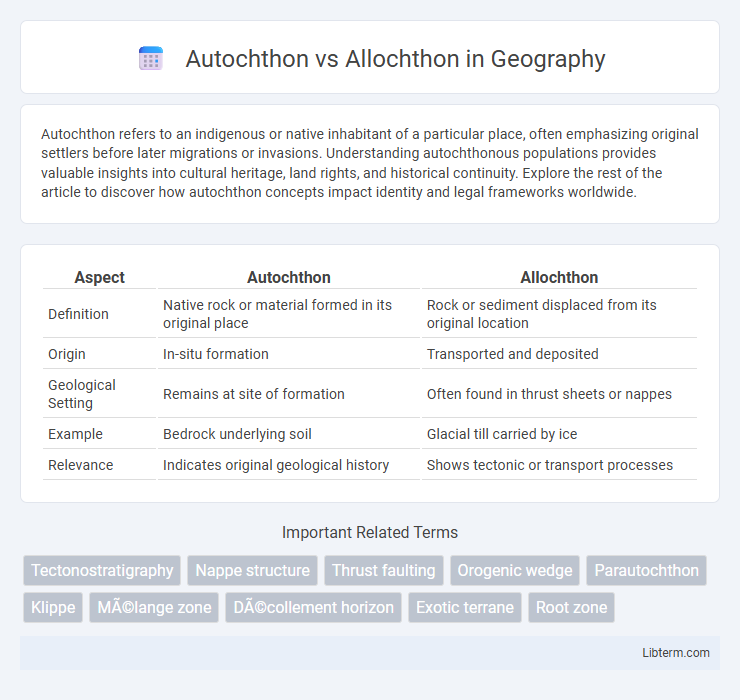Autochthon refers to an indigenous or native inhabitant of a particular place, often emphasizing original settlers before later migrations or invasions. Understanding autochthonous populations provides valuable insights into cultural heritage, land rights, and historical continuity. Explore the rest of the article to discover how autochthon concepts impact identity and legal frameworks worldwide.
Table of Comparison
| Aspect | Autochthon | Allochthon |
|---|---|---|
| Definition | Native rock or material formed in its original place | Rock or sediment displaced from its original location |
| Origin | In-situ formation | Transported and deposited |
| Geological Setting | Remains at site of formation | Often found in thrust sheets or nappes |
| Example | Bedrock underlying soil | Glacial till carried by ice |
| Relevance | Indicates original geological history | Shows tectonic or transport processes |
Understanding Autochthon and Allochthon: Core Definitions
Autochthon refers to geological formations or rocks that originate and remain in their original place, maintaining their primary location since formation. Allochthon denotes rock masses or geological units transported from their original site of formation, often by tectonic processes such as thrust faulting or overthrusting. Understanding these core definitions is essential for interpreting tectonic movements and the structural evolution of mountain belts.
Origins and Historical Context of Autochthon and Allochthon
Autochthon and allochthon refer to indigenous and non-indigenous origins, respectively, with autochthon derived from Greek meaning "sprung from the land itself." In historical contexts, autochthonous populations are considered original inhabitants of a region, often tied to myths and cultural identity, while allochthonous groups are those who migrated or were displaced into new territories. Geologically, autochthonous rock formations remain in their place of formation, contrasting with allochthonous units, which have been transported from their original locations.
Geological Significance: Autochthon vs Allochthon
Autochthonous rocks form in their original place of deposition or formation, preserving primary geological features that reflect local tectonic and sedimentary processes. In contrast, allochthonous rocks are displaced from their original sites by tectonic forces such as thrust faulting or nappes, offering critical evidence of regional orogenic events and crustal deformation. Understanding the spatial relationships between autochthonous and allochthonous units is essential for reconstructing paleogeography and interpreting the dynamics of mountain-building processes.
Key Differences Between Autochthonous and Allochthonous Formations
Autochthonous formations are geological units that originate and remain in their place of formation, exhibiting minimal displacement or transport from their source, often characterized by in situ sedimentation or rock development. Allochthonous formations are rock units that have been transported from their original location, typically by tectonic processes such as thrust faulting or glacial movement, resulting in significant displacement and often complex structural relationships. The key differences include the origin and transport history, with autochthonous formations reflecting local geological processes, while allochthonous units reveal significant tectonic transport and emplacement far from their source area.
Examples of Autochthonous Structures in Nature
Autochthonous structures in nature include coral reefs formed in situ by accumulated coral organisms, such as the Great Barrier Reef in Australia, and glacial moraines created by debris deposited directly by moving glaciers. Another example is volcanic islands like Hawaii, which emerge from localized volcanic activity on the ocean floor. These structures contrast with allochthonous deposits transported from their original location by external forces like rivers or glaciers.
Typical Allochthonous Features and Their Formation Processes
Typical allochthonous features include thrust sheets, large-scale nappes, and fault-bounded terranes transported over considerable distances from their original formation sites due to tectonic forces. These features form primarily through processes such as continental collision, subduction, and crustal shortening, which cause slices of crust to be detached and emplaced onto different geological settings. The presence of distinct stratigraphy, metamorphic gradients, and structural fabrics often characterizes allochthonous units, differentiating them from the underlying autochthonous rocks.
Applications in Earth Sciences and Tectonics
Autochthonous rocks remain in their original formation location, providing critical insights into stable crustal segments and tectonic stability in Earth sciences. Allochthonous rocks, transported from their original positions by tectonic processes such as thrust faulting or nappe formation, inform the study of orogenic belts and crustal deformation mechanisms. Understanding the distribution and characteristics of autochthonous versus allochthonous units is essential for reconstructing tectonic histories and designing models of crustal evolution.
Importance in Archaeology and Anthropology
Autochthon refers to populations or materials originating in the place where they are found, while allochthon denotes those introduced from elsewhere. Understanding the distinction aids archaeologists and anthropologists in reconstructing migration patterns, cultural exchange, and population continuity. Identifying autochthonous elements helps establish local adaptation and heritage, whereas recognizing allochthonous components reveals external influences and interactions in human history.
Autochthon and Allochthon in Ecology and Biodiversity
Autochthonous species originate and evolve within a specific ecosystem, contributing to its stability and resilience by maintaining native biodiversity and ecological balance. Allochthonous species, introduced from external habitats, can disrupt local ecosystems by competing with native species and altering habitat structures. Understanding the distinction between autochthonous and allochthonous organisms is crucial for effective biodiversity conservation and managing invasive species impacts.
Future Research Directions and Emerging Trends
Future research in autochthonous and allochthonous systems emphasizes integrating advanced geochemical and isotopic analysis techniques to better distinguish material provenance and transport mechanisms. Emerging trends include applying machine learning algorithms to large datasets for predictive modeling of sedimentary processes and exploring the impact of climate change on the dynamics between in-situ and transported geological materials. Interdisciplinary collaboration between geologists, ecologists, and data scientists is driving innovation in understanding autochthonous versus allochthonous contributions across diverse ecosystems.
Autochthon Infographic

 libterm.com
libterm.com